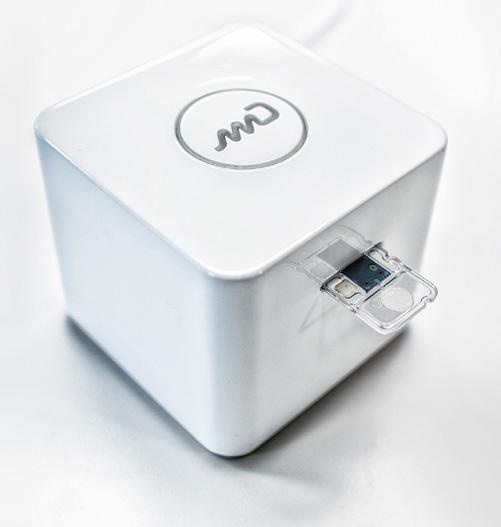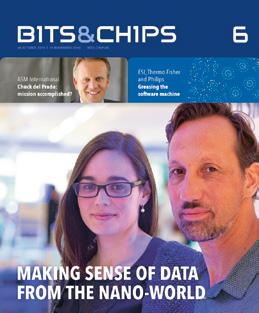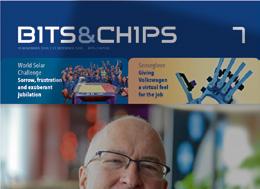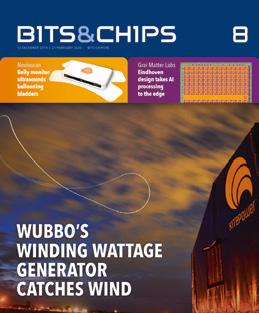
8 minute read
Chip-based diagnostics device from Leuven
Chip-based diagnostics device from Leuven could detect future outbreaks
Credit: Midiagnostics
Advertisement
Midiagnostics recently received a 14 million euro investment to bring its chip-based diagnostics platform to the market. The technology from Leuven allows users to obtain rapid test results for acute, chronic and epidemic diseases, such as future pandemics.
“B y making diagnostics easily available in airports and at border control, virus outbreaks such as the current corona pandemic can be prevented in the earliest stage, which is especially helpful if carriers aren’t showing symptoms,” explains Midiagnostics CEO Nicolas Vergauwe. “If you want to detect a sudden rise early on, you need proper technology that can be used outside classical laboratory settings. We’re fighting fires, where we should have installed smoke alarms.”
Leuven-based Midiagnostics is developing such a smoke alarm: a chip-based diagnostics platform that allows users to obtain rapid test results for acute, chronic and epidemic diseases, such as future pandemics. It recently received a 14 million euro investment to bring its solution to the market. The primary new investors are Rudi Pauwels, Belgian pharmacologist, serial entrepreneur and the company’s chairman, and Urbain Vandeurzen, one of Belgium’s leading business entrepreneurs and chairman of VMF Invest.
Jessica Vermeer
Diagnosis on a chip
The main goal of Midiagnostics is to make diagnostic information as readily available as news articles on your smartphones. Currently, diagnostics requires large facilities to execute sampling and tests. The Leuven outfit has miniaturized this to the microchip level, executing all the steps sequentially by inventive usage of the capillary effect: the chip has a very precise geometry of tiny canals, which manipulates the fluids to move in a specific way. The resulting nanofluidic processor, as Midiagnostics calls it, is embedded in a test card, which is about the size of a credit card. The compact reading system, a cube measuring 10 cm on all sides, can measure virtually any biomarker in an easily accessible sample.
The device allows for analysis of different sample types, with drops of blood being the most common. From these samples, it can detect several types of biological particles. Depending on the target molecule, the reader is equipped with a simple optical module consisting of a light source and a camera chip, which is used to detect cells, proteins and small molecules. Nucleic acids are detected directly on the chip using an electrical readout that’s fully compatible with the optical method, allowing for the development of a single reader.
The biggest advantage of the Midiagnostics solution is the elimination of sample preparation, which is a complicated, time-consuming process. Vergauwe compares his company’s chip technology to a line of dominos. “You just give the initial push by loading the sample and all steps will automatically follow.”
Midiagnostics is a spinoff of Johns Hopkins University and Imec. It was founded in 2015 as a private company based in Leuven. At that time, it was still exploring the capabilities of its silicon chip technology. “Too early for Urbain Vandeurzen to invest,” says Vergauwe. “Now, we’re ready to enter the development phase for mass production.” He emphasizes R&D will still play an important role within the company, but the initial invention is ready for the next step.
Early outbreak detection
Meanwhile, even though the coronavirus outbreak cannot be prevented anymore, test capacity remains relevant. “The current test paradigm relies on central laboratory testing. The big disadvantage is that early detection isn’t straightforward. As a consequence, you’ll start doing massive testing when it’s actually too late. Using our technology at places that allow for early detection, like airports, enables us to detect the metaphorical smoke when another house catches on fire.”
“By using adaptive power control we can reduce the wasted system power, which helps in terms of sustainability,” explains CEO Ronis Maximidis.
Credit: Maxwaves
low-frequency channels, the signals can travel further and are more resistant to inclement weather. But as the next generation network moves toward the higher,
TECHNO-ADV-FEB2020-CONT-190x115.indd 1

millimeter-wave frequencies, the distance that the signal can transmit is a real concern. Adding environmental factors, like bad weather, will only complicate the equation and further diminish the propagation.
“Rain and wind can really attenuate the signal in a significant manner. When using high-gain reflective antennas, that’s always going to be an issue,” explains Maximidis. “We developed our focal-plane-array-fed antenna with automated alignment capabilities. This provides the system with the capacity to conduct limited scanning, allowing it to automatically counteract the wind’s twist-and-sway effect on antenna masts. Furthermore, our ability to adjust the power output means we can compensate for the adverse effects of rain, making the Maxwaves solution a viable option even in poor environmental conditions.”
Recently, Maxwaves took to the rooftops of the TUE campus to put its prototype to the test. Looking to validate its technology, Maximidis’ team placed a transmitter and receiver on the top of the Vertigo and

Spinoff or startup?
At its inception, Maxwaves was slated to be a spinoff from Eindhoven University of Technology. With a recent tweak in the system’s design, the company is no longer utilizing IP from the university and Maxwaves will now be launching as a startup.
Flux buildings, on opposite ends of the campus, and successfully linked the two using its electronically controlled beam-steering method. “These tests show that our FPA offers enhanced beam-steering capabilities for point-to-point links at longer distances,” boasts the CEO. “Typical market solutions can go about 5 km in ideal conditions. When the high-frequency waves are restricted, they shift back to the lower bands, but that significantly restricts the bandwidth. With our technology, we believe we can double that and hit 10 km, while still offering the 10 Gb/s speeds – in all weather.”
28-02-20 11:18
Become a premium member for only € 59 per year and visit all Bits&Chips events with a discount!







Sign up via: bits-chips.nl/subscribe
Follow us on

Anton van Rossum anton.van.rossum@ir-search.nl

Ask the headhunter
E.K. asks:
As the managing director of an American high-tech company, I’ve been struggling for some time to fi nd the right person for a sales management vacancy in the EMEA region. Recently, I thought I’d found the ideal candidate. He had twenty years of sales experience in our specialist industry and a large international network. He scored well in all respects: technical interest, social qualities and the ambition to build something beautiful at our company. After extensive interview sessions – in which he spoke to all key people within our organization – we off ered him a contract. We quickly agreed on the terms. Th e only adjustment he demanded was that he got a permanent appointment instead of a one-year contract.
It’s our standard procedure to check references. We also did that in this case. Not that I have any doubts about his abilities, but more backgrounds about his personality from professional practice can help me get him up to speed better and faster. Strangely enough, he saw little point in a reference check. He pointed to his recommendations on Linkedin, stating that this should be enough. His colleagues from more than ten years ago might not remember enough of him and his current coworkers aren’t allowed to provide references due to company policy. I’m not comfortable with this, but I don’t want to lose him as a future sales director. What can I do to get more background information about him?
The headhunter answers:
To be frank, since the introduction of the GDPR, checking references without the candidate’s consent has become a legal minefi eld. Requesting and providing backgrounds is a form of screening. References say something about an applicant and directly or indirectly identify him or her. Th is means that they can be regarded as personal data and thus the GDPR applies.
Th e main rule is that you can only request references if the GDPR requirements are met. In short, the
screening needs to have a legitimate purpose and has to be necessary for that purpose and the applicant must be informed. Furthermore, there must be a processing basis (as stipulated in GDPR Article 6).
Conclusion: the applicant (former employee) needs to give permission to approach the sponsor (former employer) for references. Approaching the former employer without this consent may violate the GDPR. Th e same applies to the former employer providing references without permission. Th e question remains how this ‘consent requirement’ relates to the position of the Dutch Data Protection Authority, according to which permission in principle cannot be used as a valid processing basis in the relationship between a potential employer and an applicant.
It goes without saying that this legislation facilitates fantasists, cheaters and hard-core liars. Talking about future or former employees without permission can potentially lead to very unpleasant legal consequences (ie high fi nes).
In practice, however, information is obtained from candidates daily without permission having ever been given (backdoor reference checks). As soon as a résumé pops up in the inbox, the sender’s Linkedin profi le is viewed for common contacts, skills & endorsements and recommendations. To avoid legal issues, many US companies have very strict reference policies. Some won’t invite you for interviews if you haven’t provided a list of references.
To get more backgrounds about your candidate’s personality, you can also consider having him psychologically examined. Th is usually produces very reliable and useful information.










